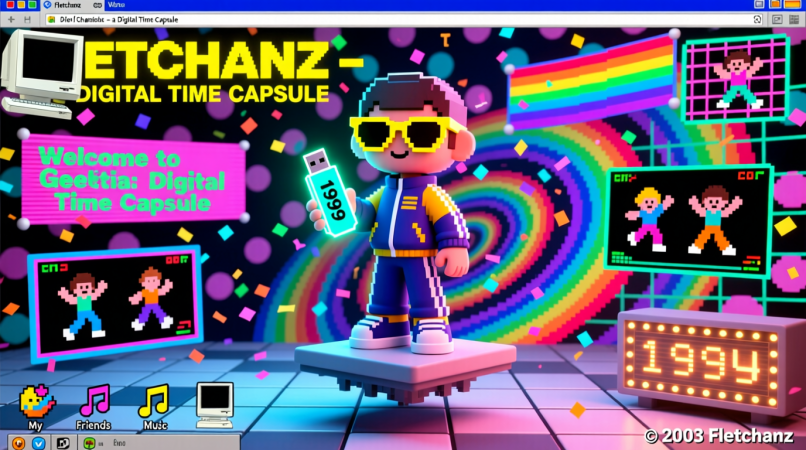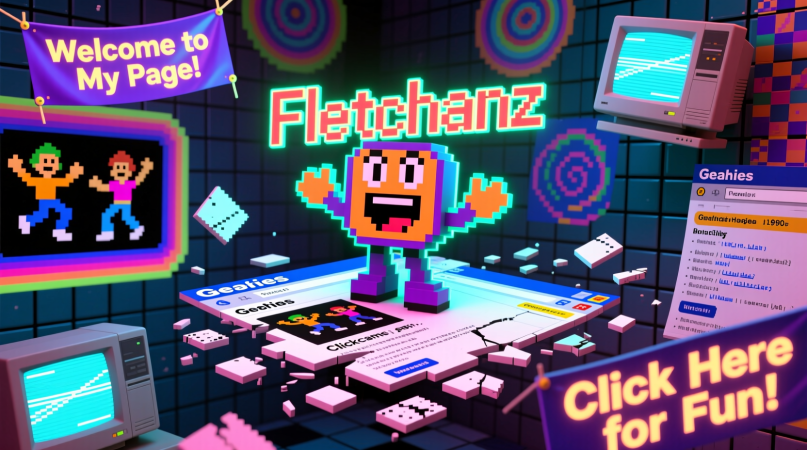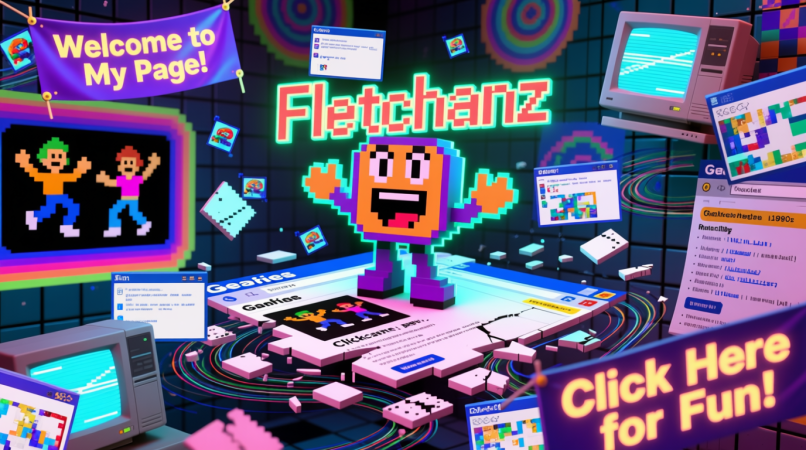In the early days of the internet, before sleek websites and social media platforms dominated our online experience, there was a simpler time when creativity flourished in its rawest form. One such example is Geocities Fletchanz—a unique corner of cyberspace that captured the essence of DIY web design during an era when personal expression reigned supreme. This article dives deep into the world of Geocities Fletchanz, exploring its origins, impact on digital culture, and enduring legacy as a relic of the internet’s golden age.
What Was Geocities Fletchanz?
To understand Geocities Fletchanz, we must first explore what made Geocities itself so revolutionary. Launched in 1994 by David Bohnett and John Rezner, Geocities became one of the first free web hosting services available to the public. It allowed users with little to no technical expertise to create their own websites using pre-designed templates or custom HTML coding. These sites were organized into “neighborhoods,” each catering to a specific theme or interest—ranging from arts and entertainment to sports and hobbies.
Geocities wasn’t just about building websites; it was about creating communities. Users could interact with one another through guestbooks, forums, and shared interests, fostering connections across geographical boundaries. For many people, this platform served as their introduction to the vast potential of the World Wide Web. And within this sprawling digital landscape, individual creators like Fletchanz carved out niches that reflected their passions and personalities.
Who Was Fletchanz?
Fletchanz emerged as one of the most memorable figures in the Geocities ecosystem. While much of the creator’s identity remains shrouded in mystery, their work speaks volumes about their dedication to crafting immersive online experiences. The name “Geocities Fletchanz” has become synonymous with quirky, offbeat humor, vibrant graphics, and a distinctively retro aesthetic that perfectly encapsulated the spirit of the late 1990s internet.
Their website stood out for several reasons:
- Visual Appeal: Fletchanz’s pages were a kaleidoscope of colors, animated GIFs, and pixel art. From spinning logos to flashing banners, every element screamed personality and effort.
- Content Diversity: Whether it was fan fiction, original artwork, or humorous commentary, Fletchanz offered something for everyone. Their eclectic mix of content kept visitors coming back for more.
- Community Engagement: Like many successful Geocities creators, Fletchanz understood the importance of interaction. They actively encouraged feedback through guestbooks and email exchanges, cultivating a loyal following over time.
While the specifics of Fletchanz’s real-life persona may never be fully known, their contributions to the Geocities community remain etched in the memories of those who stumbled upon their site during its heyday.
The Cultural Impact of Geocities Fletchanz
At its core, Geocities Fletchanz represented more than just a collection of webpages—it symbolized the democratization of creativity in the digital age. During a time when corporate giants had yet to monopolize online spaces, individuals like Fletchanz proved that anyone could carve out a space for themselves on the internet. Here are some ways in which Geocities Fletchanz left a lasting impression:
1. Pioneering Personal Branding
Long before influencers dominated Instagram and YouTube, Geocities users like Fletchanz were experimenting with personal branding. By curating content that showcased their unique voice and style, they attracted audiences who resonated with their vision. Fletchanz’s ability to blend humor, artistry, and interactivity set a precedent for future content creators navigating the ever-evolving digital landscape.
2. Nostalgia and Authenticity
Today, Geocities Fletchanz serves as a nostalgic reminder of a simpler, less commercialized internet. Unlike modern websites optimized for SEO and ad revenue, these early creations prioritized authenticity above all else. Visitors didn’t come to Fletchanz’s site because it was polished or professional—they came because it felt genuine. That sense of unfiltered self-expression continues to resonate with those yearning for the internet’s halcyon days.
3. Inspiring Future Generations
For aspiring web designers and artists, Geocities Fletchanz provided both inspiration and practical lessons. Many learned the basics of HTML, graphic design, and content creation by studying sites like this one. Even though Geocities officially shut down in 2009 (with some archives preserved by organizations like the Internet Archive), its influence persists in the work of countless creators who cut their teeth on platforms like Tumblr, WordPress, and beyond.
Why Did Geocities Decline?
Despite its initial success, Geocities eventually succumbed to the rapid evolution of technology and user expectations. Several factors contributed to its decline:
- Rise of Social Media: Platforms like MySpace, Facebook, and Twitter offered easier ways for people to connect and share content without needing to build entire websites from scratch.
- Corporate Takeover: When Yahoo acquired Geocities in 1999, changes in management and policies alienated many long-time users who valued the platform’s grassroots ethos.
- Changing Design Standards: As internet speeds improved and multimedia capabilities expanded, static HTML pages filled with GIFs and MIDI music began to feel outdated compared to dynamic, interactive experiences.
By the mid-2000s, Geocities had lost much of its relevance, but its legacy lived on through enthusiasts and preservationists determined to keep its memory alive.
Preserving the Legacy of Geocities Fletchanz
Thanks to initiatives like the Wayback Machine, fragments of Geocities Fletchanz still exist today, allowing curious netizens to revisit this iconic piece of internet history. However, preserving such artifacts is not merely about nostalgia—it’s about recognizing the cultural significance of early web pioneers. These sites represent a pivotal moment when ordinary people seized control of new technologies to tell their stories and connect with others.
Efforts to archive and celebrate Geocities have gained momentum in recent years. Online communities dedicated to retro computing and digital archaeology frequently discuss figures like Fletchanz, analyzing their contributions and speculating about their motivations. Some even recreate Geocities-style websites as a tribute to the era, blending vintage aesthetics with modern sensibilities.
Lessons Learned from Geocities Fletchanz
Reflecting on the story of Geocities Fletchanz offers valuable insights for today’s digital creators:
- Embrace Your Unique Voice: In a crowded online world, standing out requires authenticity. Just as Fletchanz captivated audiences with their quirky charm, modern creators should focus on showcasing what makes them different.
- Engage With Your Audience: Building a loyal following isn’t just about producing great content—it’s about fostering meaningful interactions. Guestbooks may be obsolete, but the principles behind them remain relevant.
- Adapt Without Losing Yourself: While technological advancements demand flexibility, staying true to your roots ensures longevity. Fletchanz thrived because they balanced innovation with consistency.
Conclusion
Geocities Fletchanz may have been just one small part of a massive online experiment, but their impact reverberates through the annals of internet history. Through bold visuals, engaging content, and a commitment to community, they exemplified the best qualities of early web culture. Though platforms like Geocities may no longer exist, their spirit lives on in the countless creators inspired by their trailblazing efforts.
As we navigate the complexities of today’s digital landscape, it’s worth remembering the lessons of Geocities Fletchanz: embrace creativity, foster connection, and never underestimate the power of a well-placed animated GIF. After all, the internet is at its best when it reflects the boundless imagination of those who inhabit it.


